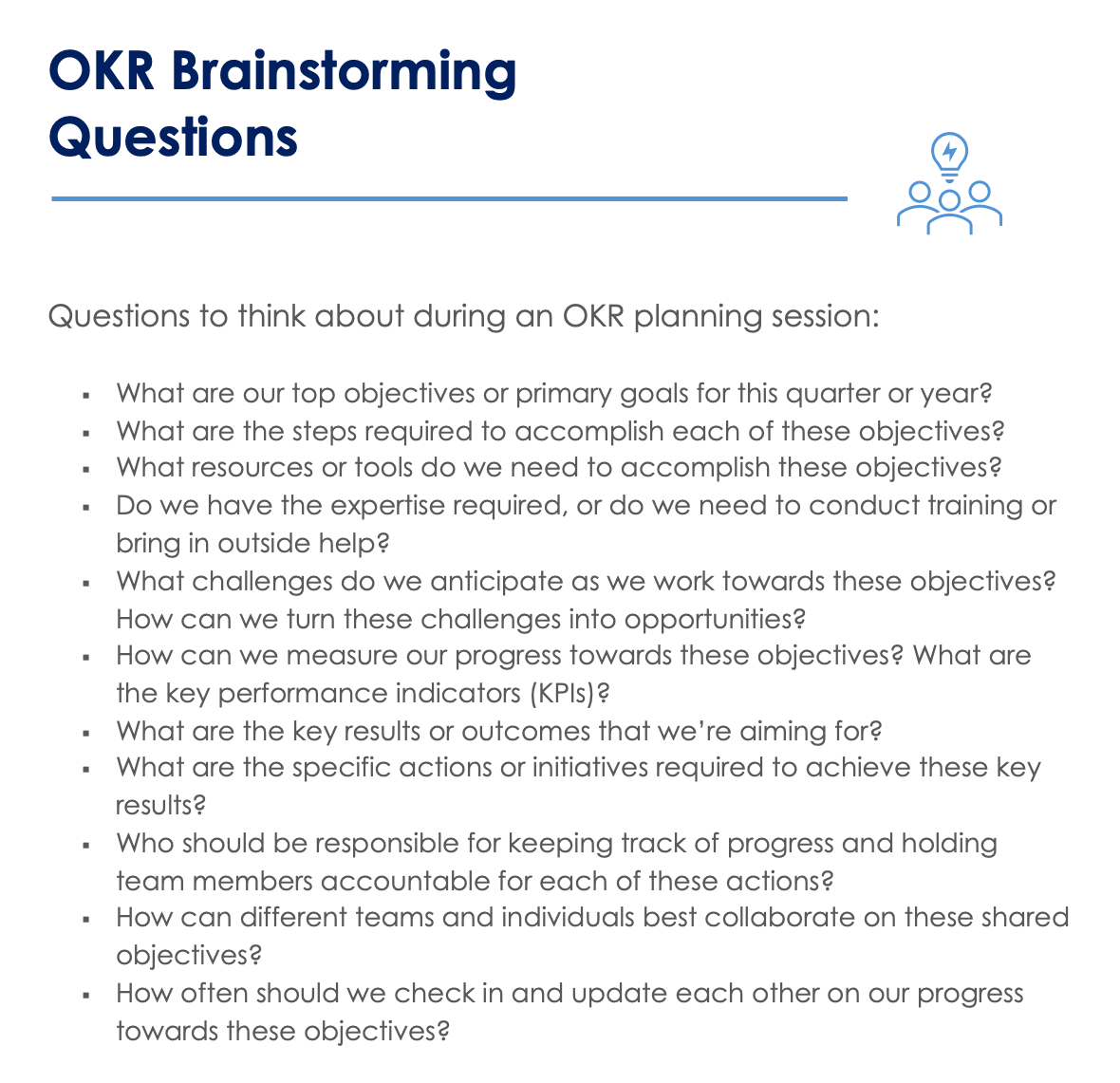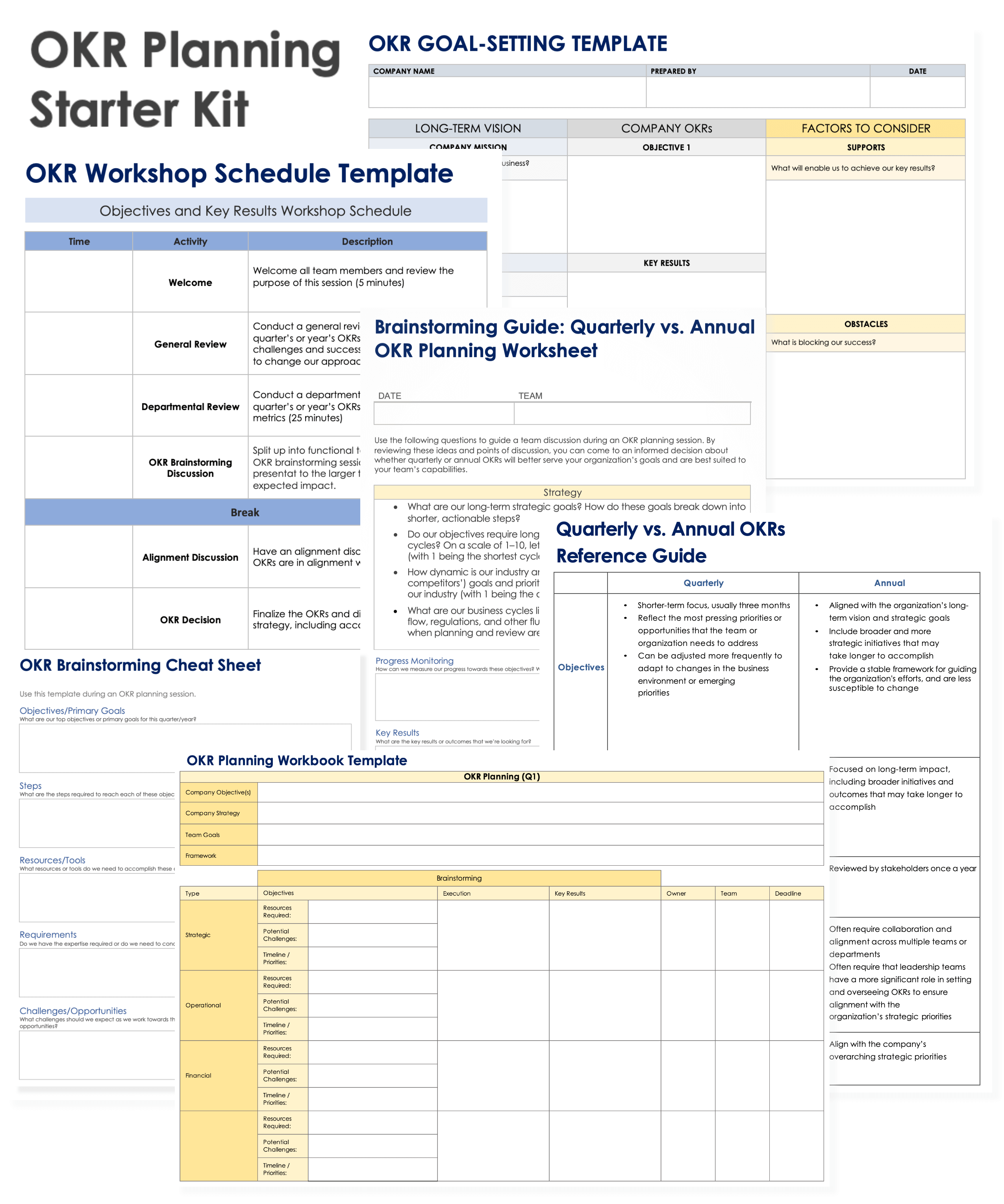What Is OKR planning?
OKR planning aims to ensure that various teams are aligned on their individual and collective objectives. The OKR approach consists of four stages: set goals, define key results, implement the plan, and gather feedback. OKR planning is the first step.
When utilized effectively, OKR planning gets all teams on the same page in terms of goals and key metrics for success, whether this planning takes place quarterly or annually. From this baseline, all teams should be able to work together successfully to achieve the stated objectives.
Steps in the OKR Planning Process
Before you set your goals, identify desired key results, or institute systems to track your success, you need to plan. Follow the steps below at the team or company level to plan your OKRs and keep your team aligned.
- Revisit the Company Strategy
The first step in planning OKRs is to revisit the company’s current strategy. This overarching strategy should be aligned with the organization’s mission statement (which is typically much broader). Once you’ve compared the strategy and mission statement, assess areas where each team can contribute.
This step isn’t mandatory for every quarter, but it’s important for when you’re introducing the OKR framework to your company or team or when you’re planning for a new year or quarter. It ensures that before you roll out the OKR method, your objectives are aligned with the broader company goals and values. Ask the following questions at the team level:
- What is our company trying to achieve? What is its big strategy? What are its big goals?
- How does this team contribute to these goals?
“I like people to have a conversation about their customers,” says Daniel Montgomery, Founder and Managing Director of Agile Strategies and author of Start Less Finish More: Building Strategic Agility with OKRs. “What value are you providing to these various customers? What do they need from you? Are there ways you could do better? These conversations about top-level strategy and current performance vis-à-vis our stakeholders — What are the problems we want to solve? Are there opportunities that we want to pursue? — start to crystallize into goals.”
- Evaluate the OKR Framework
John Doerr is the author of Measure What Matters: How Google, Bono, and the Gates Foundation Rock the World with OKRs and one of the most prominent proponents of the technique. In his observation, the methodology largely applies to startups, tech, and IT. But according to one study presented at the International Joint Conference on Industrial Engineering and Operations Management, it can be valuable in any number of other industries and businesses.
That said, once you’ve decided on your company and team goals, it’s still important to assess whether the OKR framework is suitable for your goals. The OKR framework introduces a particular culture to your workplace, and it’s not always right for everyone.
Compare the OKR framework to alternate measures, such as KPIs (key performance indicators), MBOs (management by objectives), and SMART goals, to see which method is best suited to you.
“The OKR method is best if you’re trying to get to someplace you haven’t been before, you don’t quite know how to get there, and you need a team to do it,” Montgomery says.
The OKR framework looks different for teams that focus solely on innovation, compared to older teams and companies that have to balance growth with business-as-usual. But in general, the framework is best suited to instances where there is room for risk and experimentation, and the goals involve some kind of transformation. These types of goals usually involve moving out of the individuals’ usual discipline or expertise and stepping into greater potential.
Learn more about the framework by reading our essential guide to OKRs.
- Collect Initial Ideas
OKRs differ from other planning strategies in their multi-directional nature. In other words, these goals aren’t simply dictated from the executive level using a top-down approach. At Google, for example, many teams devise about 60 percent of their goals from the bottom up.
The OKR process should involve discussions among employees and managers. Some companies require OKRs at every level, including the individual level. This step is key when writing OKRs. An initial staff meeting can provide an opportunity for employees and managers to negotiate the specifics of each OKR and to collaborate and ensure that individual, team, and company goals are all aligned.
Learn more about how to write OKRs with our comprehensive guide.
- Plan Resources and Training
This step is important if you’re introducing the OKR framework to your company for the first time. You can use a number of different resources to support the OKR planning process before you develop your final objectives, as listed below:
- Training: It’s critical to train all your employees on the OKR method and what it involves. This ensures that everyone understands the system and that you gain buy-in from the entire time before you begin setting OKRs. Your OKR planning process will run more smoothly if everyone knows what to expect, along with their roles and responsibilities.
- Templates: You can ease the process of planning OKRs by using an OKR template in either Excel or a Google Docs format. OKR templates should be user-friendly and straightforward, and you can use them to facilitate brainstorming activities.
Montgomery says, “At this stage, I'm typically working on a whiteboard,” which could be either physical or digital. “Some dedicated OKR platforms actually include a whiteboard; it turns looser information into data.” - Platform: Pick an OKR management platform that allows your team to collaborate remotely, automate workflows, and centralize your planning process. At the same time, Montgomery notes, trying to over-automate an essentially creative process can leave you with “a big soup of what other people have already thought and said.” It’s okay to keep this simple and low-tech if that’s what you need.
- Pick an OKR Facilitator
Before introducing OKRs into your organization, choose someone to lead the process and oversee the OKR project plan. Because this person will be everyone’s go-to in case of a problem, they should ideally have experience facilitating workshops and planning sessions and have goal-setting responsibilities in the company. It could be someone from Human Resources, which is often responsible for introducing OKRs or any other new system into the company culture and measuring performance. It could also be a team leader, a project manager or operations manager, an investor, or anyone with previous experience with OKRs. The OKR planning leader should be able to drive accountability with their peers.
- Conduct a Brainstorming Session
Involve employees and team leads in the brainstorming session to help begin the process for setting OKRs. Here are some brainstorming questions that you can use as a template for guiding the discussion:- What are our top objectives or primary goals for this quarter/year?
- What are the steps required for each of these objectives?
- What resources or tools do we need to accomplish these objectives?
- Do we have the expertise required, or do we need training or outside help?
- What challenges should we expect as we work toward these objectives? How can we turn these challenges into opportunities?
- How can we measure our progress toward these objectives? What are the main indicators of our performance?
- What are the key results or outcomes that we’re looking for?
- What are the specific actions or initiatives required to achieve these key results?
- Who should be in charge of keeping track of progress and holding accountability with each of these actions?
- How can different teams and individuals best collaborate on these shared objectives?
How often should we check in and update each other on our progress toward these objectives?

Download OKR Brainstorm Questions for
Microsoft Word | Adobe PDF | Google Docs
A potential OKR workshop schedule day could look like this:
- Identify Challenges
In order to properly set objectives and decide which key results to track, you need to know the main challenges your company is facing. Consult with leadership about the company’s most important obstacles and barriers to success. These could be any of the following:- Internal Challenges: These challenges come from within the company, and they can be both planned and unplanned. For example, your company could be trying to appeal to a new target audience or changing or expanding its brand image; you could be facing new budget constraints; employee morale may be low; or a new competitor may have recently entered the market.
- External Challenges: These are challenges that come from outside the company, including an unforeseen health crisis, a sociopolitical issue, or an economic recession. These external challenges may alter market conditions quickly or affect the amount of investor money or other funding the company depends on. These external factors also need to be considered when initiating the OKR planning process.
- Set Clear Priorities
At this stage, focus on gathering all the important information that you will need to set OKRs — doing so will enable you to realistically set timelines and have a clear view of your capacity. “Remember that you shouldn’t try to do everything,” advises Allan Kelly, author of Succeeding With OKRs in Agile and The Art of Agile Product Ownership. “It’s absolutely key to limit the number of objectives the team has.”
- Get Feedback
Once you’ve drafted your OKRs in the brainstorming session, allow team leads and managers to circulate feedback, and revisit the draft OKRs if necessary. This step is also important to conduct at the end of the quarter when assessing the OKRs that have already been set. Employees should see the impacts of their ideas when put into practice, so they feel more invested in the planning process.
- Plan an Execution Strategy
Initiate this process during the brainstorming session. Break down your execution plan into manageable action items, including initiatives and regular check-ins, so that OKRs don’t feel out of reach or leave employees feeling unmotivated. Initiatives are the tasks, projects, and activities that you undertake in order to achieve the stated OKRs. (See our roundup of examples of OKRs for every department for inspiration on how to write effective OKRs.)
Check-ins are regular team review sessions designated for updates and discussions about progress. “Just agree on how you’re going to check in on [the OKRs] and how you’re going to track them,” says Montgomery. “Get the commitment to keep having conversations about them and be transparent about the results.”It’s important to also set up a tracking system, which will come in handy when you revisit the process at the end of the quarter to help with Step 12.Tracking and check-ins happen throughout the implementation process, but you should also incorporate a decision on an OKR scoring system beforehand. Consider setting up an OKR dashboard to track your efforts; you can use this set of OKR tracking templates to get started.
- Cascade OKRs From Company to Team
Once the company objectives are clearly defined — whether they live on your whiteboard, spreadsheet, OKR software, or somewhere in between — teams can process and quantify their goals, as well as set their own objectives to strive for in service of the company’s larger goals.When planning team-level OKRs, remember to strike the right balance between ambitious and practical. The objectives should bring your team out of their comfort zone, but not be so far-reaching that they lose motivation. Here are some questions to brainstorm while setting team objectives:
- What is our role in achieving this company objective?
- Where should we be in three months in order to be successful?
- What needs to be changed or fixed in three months?
But remember: “Don't rush the setting process; it takes time,” advises Allan Kelly. “Setting is not planning: When setting goals, be outcome- and customer-focused. Have another meeting after you set the OKRs to decide how you will achieve them and plan the work.”
- Make Amendments
Before the end of the quarter, it’s important to review and make any adjustments necessary for the following quarter. You can use the feedback from your earlier brainstorming sessions, new feedback, and other data you’ve gathered throughout the quarter to help you make these adjustments.
OKR Planning Starter Kit

Download the OKR Planning Starter Kit
Use this free starter kit to help you plan out your quarterly or annual OKRs. This kit includes resources to help you evaluate and compare different types of OKRs, as well as set goals effectively.
In this kit, you’ll find:
- A quarterly vs. annual OKR reference chart for Adobe PDF to help decide when to do each type of OKR
- A brainstorming guide worksheet for Adobe PDF to help you decide which method to utilize
- An OKR goal-setting template for Microsoft Word to help you plan and set your goals
- An OKR planning workbook for Excel to organize your thoughts and plan your OKRs with your team
- A brainstorming cheat sheet for Microsoft Word to use during a problem-solving session
- An OKR workshop schedule for Microsoft Word to plan your day
OKR Planning Best Practices
As you set and plan your goals, here are a few tips to help you succeed. Though you don’t have to implement every tip in every OKR planning session, consider them all within the context of your team and company.
- Maximize Buy-In: Doing so can help prevent issues with communication or motivation later in the process. It also can help foresee potential issues. “Make sure everyone on the team is involved in the setting process so that they can spot any problems,” Kelly advises.
- Set Stretch Goals: “I like to call it a ‘moonshot,’” says Montgomery. “The outcome is uncertain, but nobody gets blamed or punished if you don’t get there.” Montgomery also notes that it’s especially important not to link OKR performance to compensation — “otherwise, people will play it safe.” The OKR framework is for moving into new territory, and people should feel comfortable enough to take risks and make mistakes that they can learn from.
- Be Transparent: “OKRs are public; everyone in the company should be able to see what everyone else is working on (and how they did in the past),” wrote Rick Klau, who spent nearly a decade at Google Ventures, in 2012, in a paper about how Google sets goals. Every project team member, contributor, and stakeholder should be aligned on the team and company objectives, and discussing OKRs transparently ensures accountability and cooperation. Once the team discusses and agrees upon objectives, you can also identify a clear set of key results.
- Be Realistic: Allan Kelly considers one objective per quarter to be ideal, while Daniel Montgomery generally follows the rule of “three, plus or minus one.” They both agree that for most businesses — that is, those focusing on growth rather than solely innovation — it’s important to be realistic, even while being ambitious.
- Stay on Offense: The OKR framework is not for damage control or firefighting. It’s for growth, transformation, and change. Avoid falling into a defense stance, or sandbagging — piling up a fortification just to hold back a flood.
- Don’t Forget Business-as-Usual: At the same time, it’s important to limit the number of stretch goals you set. If your company is young or your team’s only focus is innovation, you might have the bandwidth for more OKRs than a more mature company. But Montgomery notes, older organizations also need to “keep selling what they're already selling.” To do this, Allan Kelly recommends keeping an “OKR #0.” This keeps the rest of your OKRs clearly connected to your BAU, backlog, or other “support activities.”
- Consult Experts: “I often state that ‘a little structure goes a long way toward desired outcomes,’” says Doug Gray, CEO of Action Learning Associates, LLC. “There are two types of objectives or outcomes: behavioral and performance. Most teams do better when an external facilitator drives the process with a regular cadence and executive involvement.”
- Focus on Impact: Prioritize objectives that move the needle with the company’s larger goals for success, as well as address critical challenges and timely opportunities.
- Avoid Wordiness: To keep the focus on growth and innovation, even if BAU needs to be taken into account, it’s important to write OKRs that are short, clear, and concise, and that lend themselves to “timely resolution of disagreements,” according to Vetri Vellore, a former VP at Microsoft and author of OKRs for All: Making Objectives and Key Results Work for Your Entire Organization. “Keep the planning process concise, and avoid spending too much time on wording,” he advises.
OKR Quarterly Planning vs. OKR Annual Planning
Annual OKR planning is the strategic process of defining an organization’s or a team’s objectives and key results over the course of a full year. Quarterly OKR planning defines these objectives and key results for a three-month, or quarterly, period.
Quarterly OKR planning often involves breaking down annual goals into shorter-term action items. During quarterly OKR planning, teams define their organization’s and their own objectives to help them achieve their quarterly goals. These quarterly goals should directly drive progress toward the organization’s longer-term goals.
Opinions vary on which type of planning works best for an organization. For some, it works best to choose one or the other; for others, it might be best to use both for different purposes. But before you can assess this for your company, it’s important to consider the broad ways in which the two strategies and their impacts differ.
- Flexibility: Different timelines means different levels of flexibility. One major difference between annual and quarterly OKRs is that annual OKRs encourage more longer-term strategic planning, while quarterly OKRs encourage more flexibility and greater responsiveness to changing markets and conditions.
- Forethought: Setting and planning annual OKRs requires more forethought than setting and planning quarterly OKRs, since annual OKRs need to align with a longer-term company mission.
- Feedback: Depending on the timeline of your goal setting, you will have different approaches to evaluating your systems and implementing changes. Annual OKRs typically involve review and evaluation at the end of every year, while quarterly OKRs require conducting this review every three months.
According to Allan Kelly and Dan Montgomery, quarterly OKRs are a must-have for teams. Teams can set annual OKRs, but this isn’t necessary. “Even if longer-term goals are not formulated as OKRs, teams should know what are the company goals and priorities for the longer term. Then, when they set quarterly OKRs, they should be producing OKRs that support those long-term OKRs,” Kelly explains.
Montgomery agrees: “I wouldn’t do two separate OKRs. It’s just too much to keep track of. We set annual goals, but we don’t actually set OKRs for the year. We break the annual goal down into the quarters, and then set OKRs for the quarter.”
Even if you use both annual and quarterly goals, it’s important to make sure that they’re connected, so that a focus on one fully supports the other, rather than distracting from it. “What do things need to look like a year from now?” Montgomery asks. “Then, what needs to be true in 90 days for us to feel convinced that we’re going to get to that outcome in a year?”
Quarterly OKR planning
Quarterly OKRs keep employees focused on their stated goals for a three-month period, but their efforts should also align to the company’s annual goals. Setting quarterly OKRs should ideally help you define your annual goals and strategy in terms of more manageable targets.
Quarterly OKRs can help teams see how their weekly or daily tasks fit into their overarching objectives. They also have several advantages over annual OKRs. For example, they have the following qualities:
- Simple: Shorter timelines means that OKRs have to be simpler and more actionable.
- Flexible: Quarterly OKRs are necessarily more agile, meaning that they should be able to adapt to changing situations more easily.
- Repetitive: Setting, planning, and evaluating OKRs every 90 days enables an iterative learning process where teams have the time and space to try the same things in new ways, experiment, and build on past mistakes. It also offers more frequent opportunities to celebrate small successes.
- Top of Mind: Annual goals may be susceptible to a “set it and forget it” mindset. With a 90-day timeframe, this is far less likely.
- Receptive to Change: “Quarterly OKR feedback sessions are much more effective than annual sessions,” says Doug Gray. “Related research abounds from annual performance reviews (which have low value) versus quarterly or monthly or weekly feedback sessions. As millennials demand more feedback from other work groups or clients in the workforce, those sessions may become more frequent and even more valuable.” These quicker feedback loops means that you will be more ready for change — and better able to make improvements — as you wrap up the quarter.
- Not Too Stressful: The ideal OKR success rate is between 60 and 70 percent. Removing the expectation of a perfect score leaves more room for mistakes, new lessons, and change.
- Just Stressful Enough: Because of the time constraint that they come with, quarterly OKRs have the potential to inspire more creative thinking, focus, momentum, and efficiency. This is especially valuable in cases where the company faces external challenges, such as rapidly changing market dynamics or emerging trends.
These particular qualities make quarterly OKRs especially useful when the company is in an environment characterized by the following:
- Constraint: Allocating resources based on shorter-term priorities can enable teams to optimize their workforce and budget by planning at a more detailed level.
- Experimentation: Setting out to do something you’ve never done before is an important reason for using the OKR system. Quarterly OKRs allow for more room to experiment, test hypotheses, and learn from mistakes; because they are shorter-term, they come with less risk of time lost when mistakes happen.
- Low Morale: Quarterly OKRs keep a team focused on more manageable goals — and since they require reevaluation every three months rather than every year, they are useful to motivate employees more regularly and celebrate achievements as well as to adopt course-correction measures.
- Uncertainty: For young companies such as startups or in rapidly changing industries such as healthcare or technology, quarterly OKRs are useful for setting goals that you may need to quickly adjust. If these companies are experiencing growth in a volatile market, then it’s important to have these shorter timeframes, rather than running the risk of having to make longer-term predictions.
Annual OKR planning
Annual OKR planning involves defining an organization’s objectives and goals over the course of a full year, as well as laying out the results that will be used to measure progress toward those goals. Annual OKRs are more top-level than quarterly OKRs, and they offer a general roadmap or compass for developing strategies and making decisions.
More so than quarterly OKRs, annual OKRs enable the following:
- Collaboration: Because annual OKRs are more high-level than quarterly OKRs, they require coordination between different departments. This provides the opportunity for a wide range of teams to collaborate toward shared goals, building a sense of appreciation and community within the organization.
- Resource Planning: The high-level roadmap offered by annual OKRs helps organizations set priorities and allocate resources for longer-term goals, such as investing in research and development.
- Strategic Planning: The longer time frame of annual OKRs affords a company time to plan more ambitious initiatives, such as launching new products, entering new markets, or developing new processes. This enables greater potential for impact within and by the organization.
- Time: There is less pressure on employees in the case of annual OKRs. Since evaluations and progress reports take place once a year, teams have the flexibility to make up for lost time if needed. Annual OKRs also allow organizations to measure the impact of their activities over the course of a year and more, and then make strategic decisions for the long run.
- Transparency With Stakeholders: Annual OKRs provide a framework to include the interests of investors, clients, and other stakeholders outside of the organization’s immediate circle, who are interested in the organization’s overall growth. The annual cycle encourages progress reports that can be shared with these stakeholders and improve confidence in the organization.
In several situations, annual OKRs may be better suited to an organization than quarterly OKRs:
- Annual Sales Cycle: Industries such as education, insurance, or real estate might be more suited to annual OKRs since they involve buying processes that require a lot of lead time or are subject to seasonal change.
- Established Routines: Organizations that have well-established routines may choose to use annual OKRs over quarterly OKRs to avoid introducing new processes or potential disruptions.
- Long-Term Projects: Intensive, longer-term initiatives that require adequate time for research and development — especially if the resources for R&D or administration are limited — may be better suited to annual planning than quarterly planning.
- Need for Smooth Workflow: Annual OKRs require annual check-ins and evaluations to reassess whether they are appropriate for the following year. This may be more suitable for companies than quarterly OKRs, which have cycles involving more frequent pauses that may be disruptive to workflow.
- Stable Environment: Annual OKRs are suitable for organizations that belong to a relatively stable industry, such as the food industry, where you can more easily foresee and plan for changes.
Plan, Track, and Execute on OKRs with Real-Time Work Management in Smartsheet
Empower your people to go above and beyond with a flexible platform designed to match the needs of your team — and adapt as those needs change.
The Smartsheet platform makes it easy to plan, capture, manage, and report on work from anywhere, helping your team be more effective and get more done. Report on key metrics and get real-time visibility into work as it happens with roll-up reports, dashboards, and automated workflows built to keep your team connected and informed.
When teams have clarity into the work getting done, there’s no telling how much more they can accomplish in the same amount of time. Try Smartsheet for free, today.




